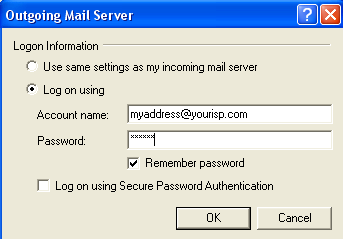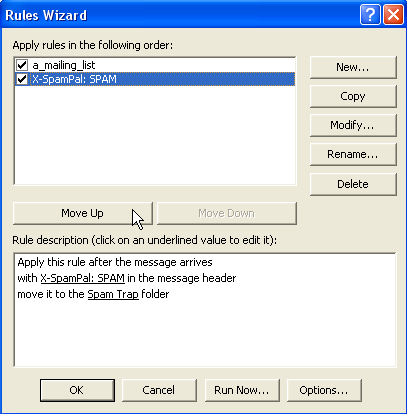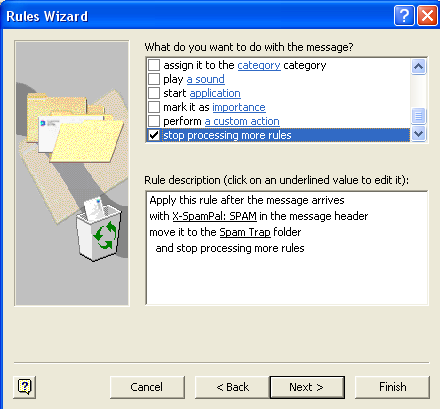This page gives instructions
on installing and setting-up SpamPal for use with the e-mail program
Outlook 2000
|
|
1. Install
SpamPal
2. Configure
SpamPal
3. Configure
your email program
3.1 Change your POP3 settings
3.2 Change your IMAP4 Settings
3.3 Change your SMTP settings
3.4 Create Filter/Message rules
4. Email
Virus Scanners and Firewalls
5. Whitelist
friends and contacts
5.1 Export your contacts email addresses
|
|
Start installation by double-clicking on the SpamPal
Setup program (spampal.exe) and follow
the on-screen instructions. Upon completion, SpamPal will run, showing
its pink umbrella icon in your system tray.
If this installation is an upgrade of SpamPal
then the existing configuration of Outlook is retained and the process
is now complete. If not, i.e. this is a new installation of SpamPal,
proceed with the steps below.
|
::Top:: |
| All you
need to know about extra configuration can be found here |
::Top:: |
| Now
you have set up SpamPal, you need to tell your email program to fetch
your mail through the SpamPal proxy rather than directly from your
ISP. |
::Top:: |
|
Load Outlook then go to Tools, Accounts:
|
| Don't
worry; instead of going to Tools,
Accounts; you will need
to go to Tools...and
then Services |
|
|
|
| We'll start
with the first account (most people will only have one). Select it
from the list and click Properties,
followed by clicking on the Servers Tab.
You should see a window a like this: |
|
|
To reconfigure your email program,
first make a careful note of your original settings.
You should append whatever value
you currently have in your Incoming
Mail Server (POP3) setting, to whatever
you currently have in the User
Name field (seperated
with a @ sign), and change the Incoming
Mail Server (POP3) setting to 127.0.0.1.
e.g. if your original values were:
Incoming Mail Server: your.mailserver.com
User Name: fred.bloggs
then you would, for example, change them to:
Incoming Mail Server: 127.0.0.1
User Name: fred.bloggs@your.mailserver.com
|
You
may, at this point, get an error message about SpamPal not being
able to listen on the standard POP3 port.This is nothing to
be worried about; just write down the port number SpamPal tells
you and continue with this guide
This message means SpamPal is using Port 1110
instead of 110.
You don't have to put it into SpamPal because SpamPal already
knows it is using port 110.
Instead, you have to tell your email program (for example Outlook
Express) to use port 1110
instead of 110.
|
|
| Don't
worry; just add @localhost to the username and leave the server
name as is |
|
| continue
regardless; SpamPal copes with usernames that contain two @s
without difficulty. |
|
Click the Settings...
button beside it. Now, select Log
on using and enter
your original
username and password
i.e..
What they were before you modified the username to install
SpamPal

|
|
|
| Incoming
Mail (POP3):mail.btopenworld.com |
Incoming
Mail (POP3): 127.0.0.1 |
| Username: fred.bloggs |
Username: fred.bloggs@mail.btopenworld.com |
| Incoming
Mail (POP3): pop.west.cox.net |
Incoming
Mail (POP3): 127.0.0.1 |
| Username: johnsmith |
Username:johnsmith@pop.west.cox.net |
| Incoming
Mail (POP3): pop.telus.net |
Incoming
Mail (POP3): 127.0.0.1 |
| Username: fax07734 |
fax07734@pop.telus.net |
| Incoming
Mail (POP3): 192.168.1.1 |
Incoming
Mail (POP3): 127.0.0.1 |
| Username: mary_jones |
Username: mary_jones@192.168.1.1 |
|
The
above Incoming POP3
Server Name, can be called:
Incoming Mail
Server, POP3 server, POP3 Username
or Account Name depending on your email program.
There are also two ways of specifying the local
server name, which should mean exactly the same thing (but on
some system only one of them will work): localhost
or 127.0.0.1 |
|
| Now
click OK to confirm, and repeat this for all the remaining accounts. When
you're done, close the Accounts window.
Now try to check your mail; if you don't get any
errors, continue to the next step.
You may be asked to re-enter your POP3 passwords; this is nothing
to worry about. If you get an error from Outlook, check that you've
configured the incoming POP3 server to
localhost and, if necessary, that
the port has been set right. If you get
an error from SpamPal, check you've added the servername to the
username correctly, and that your Internet connection is active.
|
| If there is a need to change you POP3 or SMTP ports,
then start with the first account (most people will only have one).
Select it and then click Properties.
Go to the Advanced tab of the window
that comes up, which should look a bit like this: |
|
|
| The
default Server
Timouts of 1 minute
can be a little too small an amout when using SpamPal.
If you are finding your email is timing out then perhaps
increase this figure to 4
minutes. |
|
| If you are still having a problem,
why not give this setup page a
try |
::Top:: |
| Load Outlook then go to Tools, Accounts: |
|
|
| We'll start with the first account
(most people will only have one). Select it from the list and click Properties,
followed by clicking on the Servers Tab.
You should see a window a like this: |
You'll need to make changes to the Incoming
Mail Server (IMAP) and User Name fields.
Write down the name of your Incoming Mail Server (IMAP) (e.g..imap.yourisp.com)
and then replace this with 127.0.0.1
Now add an @ symbol and the Incoming
Mail Server (IMAP) that you wrote down earlier, to the Username
logon box (e.g.. my_login_name@imap.yourisp.com)
|
|
| When you check your mail, you should
also notice that you only get non-spam email
in your inbox, as the spam marked message are now in a new folder
called spamtrap, which is created
by SpamPal to store all your spam marked messages: |
|
| If there is a need to change you
IMAP or SMTP ports,
then start with the first account (most people will only have one).
Select it and then click Properties.
Go to the Advanced tab of the window
that comes up, which should look a bit like this: |
|
| The
default Server Timouts of
1 minute can be a little too small an amout when using SpamPal.
If you are finding your email is timing out then perhaps
increase this figure to 4
minutes. |
|
::Top:: |
If you wish to use SpamPal's SMTP
Proxy to auto-whitelist any email addresses that you send to, you
will need to change Outlook's SMTP settings, as follows
Load Outlook then go to Tools, Accounts: |
|
|
| We'll start with the first account
(most people will only have one). Select it from the list and click Properties,
followed by clicking on the Servers Tab.
You should see a window a like this: |
|
|
Now, take a note of your current Outgoing
mail Server (SMTP), for example: smtp.myisp.co.uk
Now change the current Outgoing mail Server (SMTP),
to: 127.0.0.1 |
Click the Settings...
button beside it. Now, select Log
on using and enter
your original
username and password
i.e.. What
they were before you modified the username to
install SpamPal

|
|
Now, take
a note of your current Outgoing mail Server
(SMTP), for example: smtp.myisp.co.uk
Now change the current Outgoing mail Server
(SMTP), to: 127.0.0.1
Now go to SpamPal's Connections page: |
|
|
|
Now click on Add
port and change the Port
Type to SMTP
Now, change the Server Name to the Outgoing
mail Server (SMTP) you noted down earlier,
e.g..smtp.myisp.co.uk
|
|
|
| Now, whenever
you send an email, SpamPal will automatically auto-whitelist it |
Occasionally,
a spammer might forge the email address of someone who is
in your auto-whitelist - for example, a colleague or an alternate
email address or yours. While you don't want to put this
person
in your blacklist because they send you lots of genuine email,
you don't want them to end up in your auto-whitelist and
bypass
SpamPal's spam-checking features.
Clicking on the Exclusions
pane will bring up a window into which you can enter the email
addresses of people who should never be added to the auto-whitelist.
Just add your colleagues here and you won't have to worry
about spammers forging their addresses to bypass SpamPal's
filtering. You can even add your entire employer's domain
- e.g. *@acme-widgets.com |
|
::Top:: |
If you are are using an IMAP4 server, you
will not need to setup a filter/message rule on your email program,
as SpamPal moves any spam tagged messages automatically into a folder called inbox.spamtrap on
your
server.
If you are are using a POP3 server
and want your email program to automatically filter the SpamPal-marked messages
into a separate Mailbox, so that you can more easily review them, continue
as follows |
|
Go to Rules Wizard
in the Tools menu, this will bring up
a list of all of the filters (or as Outlook calls them, rules) that
are current set up. Click New to create
a new one.
Choose to Check messages
when they arrive and click next. |
|
|
Using
more recent versions of Outlook, you need to create a new
rule using:
Tools/Rules Wizard,
Select New...,
and then Select start
from blank rule |
|
|
Now we will make a filter to transfer everything
containing SpamPal's special header into a spam folder.
First, check the condition with
specific words in the message header
Now click the blue specific
words in the box at the bottom; type X-SpamPal:
SPAM into the field at the top of the window
that appears, and click OK then click
Next.
|
|
|
|
Then, check the action move
it to the specified folder. then click the blue specified
and click New to create a new folder
called Spam Trap (or whatever you would
like to call your spam folder).
Ensure that the Folder Contains dropdown
shows Mail Items , and select which
folder you wish to place the new folder inside of. Then click
OK.
|
|
|
|
|
|
If you would like a shortcut added to the Outlook
shortcut bar that points to the new folder click Yes
otherwise click No.
Click OK then
Next.
Check any exceptions to the rule you may wish
to use (recommend not checking any) and click Next.
You should end up with a rule looking a bit like
this:
|
|
|
|
Give your filter an appropriate
name, for example, SpamPal Rule and click Finish
to create it, then OK to dismiss the
mail rules window.
So, if you only have one rule setup, your rule should look like this
screen: |
|
|
Make
sure your new rule for SpamPal is first
in the list, if you have a lot of other message rules you
use. In this example, you can see that the SpamPal rule,
needs to be moved up a place, by highlighting the SpamPal
rule
and clicking Move Up

|
|
Make sure
your SpamPal rule ends with And
Stop processing more rules

|
|
| If
you have a lot of blocked senders then it is worth Removing
them from the list, as SpamPal
will do a much better job of coping with Spam and removing the
blocked senders will also speed up the processing of email. |
|
|
|
|
|
::Top:: |
|
Specific instructions for using a variety of email
virus scanners with SpamPal can be found on the main
installation page
Some email virus filters want to sit between your
mail program and your mail server in just the way that SpamPal does.
There's actually no reason why they can't; you just have them up
in serial so that your virus filter fetches its mail through SpamPal
rather than directly from your mailserver, and then your email program
fetches the mail through the virus filter.
|
::Top:: |
|
In order to speed up the processing of your emails
and to prevent SpamPal from marking your friends or contact's emails
as spam, it's a good idea at this point to whitelist all your important
email addresses.
This can be done in four ways:
a) Use the pop3
automatic whitelist: this will whitelist non-spam
email's that you receive on a frequent basis
b) Use the smtp
automatic whitelist: which (if setup in 3.3)
will whitelist all email addresses that you send out
|
| If
you are using this, especially in a business, as this is recording
all outgoing addresses, some people might view this as an infringement
upon their privacy, (if you are in UK you need to tell staff
of this policy before you start collecting data) |
|
|
c) use
the Add to Whitelist
option on SpamPal's system tray: to manually
whitelist your email addresses by typing in an address (or by using
the dropdown box; to select from a list of recently received address):
|
|
|
| d)
You can use this
procedure to automatically
export your Outlook contacts or you can use SpamPal Whitelist
Email Addresses page, to manually
whitelist your email addresses: |
|
|
The
whitelist function only looks for email addresses in certain
headers of your email.
These headers are currently: From:,
Reply-To:,
Sender:, Mailing-List:
and Return-Path: |
|
|
Initially,
you will notice that using SpamPal makes fetching your email a little
slower. This is because SpamPal has to check everything against
the DNSBL lists (Public Blacklists) to see what email's are from
a spammer and which aren't.
However,
through it's Auto-Whitelist feature(s), SpamPal will quickly learn
about the people and machines that send you lots of email, and adds
them to a list of trusted senders. Because they're trusted, SpamPal
doesn't waste time any checking the DNSBL lists (Public Blacklists)
for them and so the more you use SpamPal, the quicker it will get.
There are more hints and tip on how to optimise SpamPal here |
::Top:: |
| You
can use this procedure
to automatically export
your Outlook contact's email addresses,
so that you can quickly whitelist your contacts which will speed
up the processing of your emails and to prevent SpamPal from marking
your
friends
or contact's emails
as spam. |
| This completes
the installation and setup. |
::Top:: |